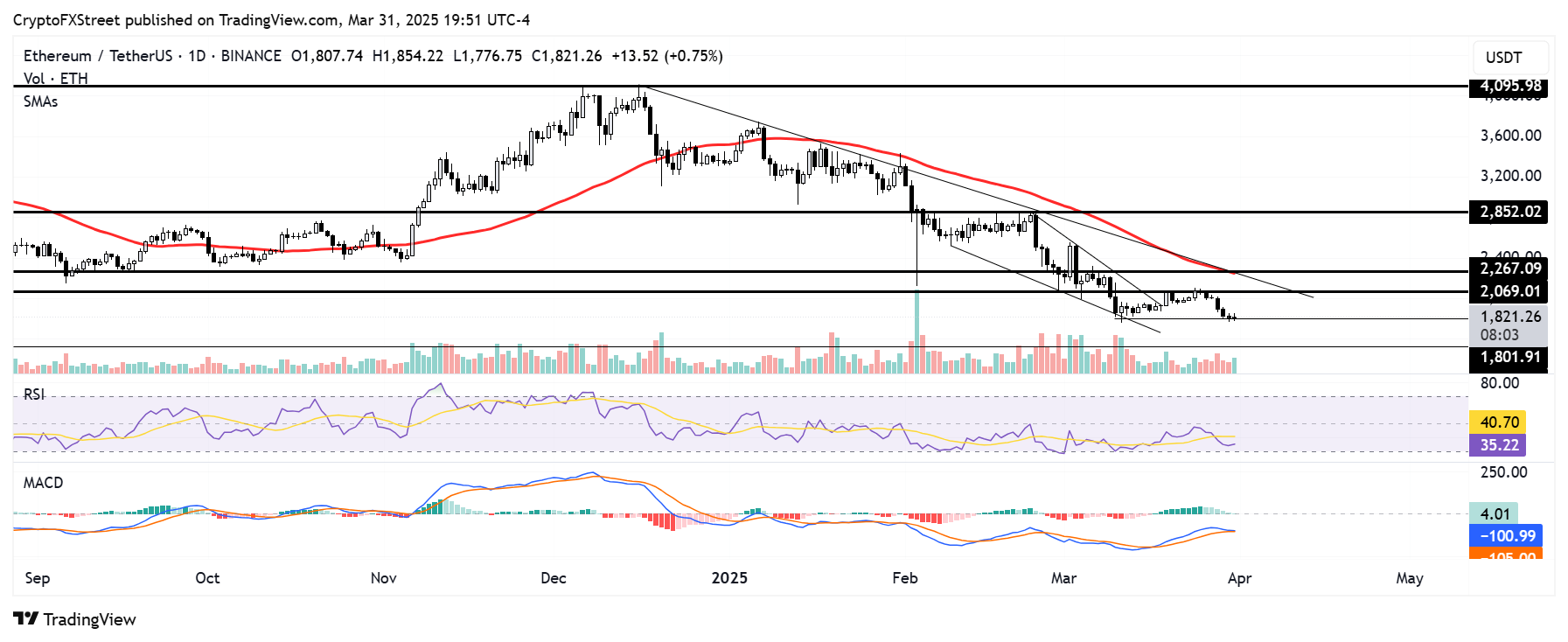Ethereum Price Forecast: Short-term holders spark $400 million in realized losses, staking
March 31, 2025
- Ethereum short-term holders capitulated, realizing $400 million in losses following increased risk-off sentiment surrounding President Trump’s reciprocal tariff announcement.
- Despite the capitulation, ETH exchange and staking flows indicate most investors lean toward a bullish outlook.
- ETH risks further downside pressure if it sustains a firm decline below $1,800.
Ethereum (ETH) bounced off the $1,800 support on Monday following increased selling pressure from short-term holders (STHs) and tensions surrounding President Donald Trump’s reciprocal tariff kick-off on April 2. While the near-term outlook suggests caution, declining ETH exchange reserves and rising staking balance could help keep prices afloat.
Ethereum short-term holders are expressing increased risk-off sentiment as market participants remain uncertain about how prices may react to April 2 “Liberation Day,” during which Trump plans to impose reciprocal tariffs and increase duties on US trading partners.
The consistent spikes in the Dormant Circulation metric show that short-term holders — primarily coins that were last moved between the past six to three months — accelerated their distribution in March.
ETH dormant circulation. Source: Santiment
In the past few hours, these cohorts increased their distribution again, with several investors potentially selling at a loss, according to the Network Realized Profit/Loss metric. The metric shows that recent sellers realized nearly $400 million in losses on Monday.
Similar spikes of realized losses are visible throughout March, indicating capitulation from most STHs, which are responsible for a majority of the distribution during the month. Historically, prices tend to find a bottom after the selling pressure from STHs has been washed out of the market. However, a further breakdown is expected if long-term holders join in the distribution.
ETH realized profit/loss. Source: Santiment
Meanwhile, investors holding between 1K – 10K ETH increased their distribution in the past two weeks, scaling down their collective balance by 160K ETH. ETH’s extended downtrend and underperformance could be fueling their divesting, considering this class of investors consistently increased their holdings since January until recently
On the other hand, whales holding between 10K -100K ETH expanded their balance by 290K ETH over the weekend, indicating diverging sentiment between the two classes of investors.
ETH supply distribution. Source: Santiment
This follows ETH exchange reserves remaining at low levels after investors pulled out 940K ETH during the month. Most of the funds potentially flowed from exchanges to staking protocols, considering ETH’s total value staked surged by about 530K ETH in the past three weeks. This signals a preference for long-term holding despite prices remaining down.
ETH total value staked. Source: CryptoQuant
Ethereum saw $63.18 million in futures liquidations in the past 24 hours, per Coinglass data. The total amount of liquidated long and short positions is $37.33 million and $25.85 million, respectively.
ETH bounced off the $1,800 support level after declining over 10% from Friday into the weekend. The move comes after ETH broke out of a falling wedge pattern before seeing a rejection at the $2,070 resistance last week. A bullish outlook is still valid if buyers hold the support near $1,800.
ETH/USDT daily chart
A breakout above $2,070 and the key descending trendline resistance extending from December 16 will validate a bullish trend. However, the resistance could prove a major hurdle as it is also strengthened by the 50-day Simple Moving Average (SMA).
On the downside, ETH could validate a bearish continuation pattern if it sustains a firm decline below $1,800. Such a move could see ETH finding support at $1,500.
The Relative Strength Index (RSI) is below its neutral level. The Moving Average Convergence Divergence (MACD) line is testing its moving average line while its histogram bars are on the verge of flipping negative. A crossover below could accelerate the downside pressure.
Ethereum is a decentralized open-source blockchain with smart contracts functionality. Its native currency Ether (ETH), is the second-largest cryptocurrency and number one altcoin by market capitalization. The Ethereum network is tailored for building crypto solutions like decentralized finance (DeFi), GameFi, non-fungible tokens (NFTs), decentralized autonomous organizations (DAOs), etc.
Ethereum is a public decentralized blockchain technology, where developers can build and deploy applications that function without the need for a central authority. To make this easier, the network leverages the Solidity programming language and Ethereum virtual machine which helps developers create and launch applications with smart contract functionality.
Smart contracts are publicly verifiable codes that automates agreements between two or more parties. Basically, these codes self-execute encoded actions when predetermined conditions are met.
Staking is a process of earning yield on your idle crypto assets by locking them in a crypto protocol for a specified duration as a means of contributing to its security. Ethereum transitioned from a Proof-of-Work (PoW) to a Proof-of-Stake (PoS) consensus mechanism on September 15, 2022, in an event christened “The Merge.” The Merge was a key part of Ethereum’s roadmap to achieve high-level scalability, decentralization and security while remaining sustainable. Unlike PoW, which requires the use of expensive hardware, PoS reduces the barrier of entry for validators by leveraging the use of crypto tokens as the core foundation of its consensus process.
Gas is the unit for measuring transaction fees that users pay for conducting transactions on Ethereum. During periods of network congestion, gas can be extremely high, causing validators to prioritize transactions based on their fees.
Share:
Cryptos feed
Information on these pages contains forward-looking statements that involve risks and uncertainties. Markets and instruments profiled on this page are for informational purposes only and should not in any way come across as a recommendation to buy or sell in these assets. You should do your own thorough research before making any investment decisions. FXStreet does not in any way guarantee that this information is free from mistakes, errors, or material misstatements. It also does not guarantee that this information is of a timely nature. Investing in Open Markets involves a great deal of risk, including the loss of all or a portion of your investment, as well as emotional distress. All risks, losses and costs associated with investing, including total loss of principal, are your responsibility. The views and opinions expressed in this article are those of the authors and do not necessarily reflect the official policy or position of FXStreet nor its advertisers. The author will not be held responsible for information that is found at the end of links posted on this page.
If not otherwise explicitly mentioned in the body of the article, at the time of writing, the author has no position in any stock mentioned in this article and no business relationship with any company mentioned. The author has not received compensation for writing this article, other than from FXStreet.
FXStreet and the author do not provide personalized recommendations. The author makes no representations as to the accuracy, completeness, or suitability of this information. FXStreet and the author will not be liable for any errors, omissions or any losses, injuries or damages arising from this information and its display or use. Errors and omissions excepted.
The author and FXStreet are not registered investment advisors and nothing in this article is intended to be investment advice.
Search
RECENT PRESS RELEASES
Related Post
%20%5B00.27.54,%2001%20Apr,%202025%5D-638790631487289119.png)
%20%5B00.27.58,%2001%20Apr,%202025%5D-638790631847374826.png)
%20%5B00.28.06,%2001%20Apr,%202025%5D-638790632274074674.png)
-638790632629395236.png)





